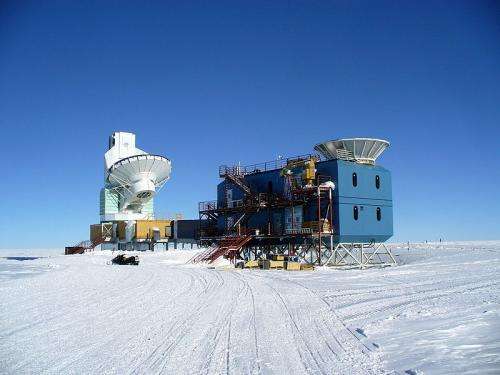May 9, 2014 report
Pair of noted physicists contemplate future of cosmology after detection of primordial gravitational waves

(Phys.org) —Physicists Joseph Silk of Institut d'Astrophysique de Paris and Jens Chluba of Johns Hopkins University have together published a Perspective piece in the journal Science, where they discuss the future of cosmological research in the wake of the detection two month ago, of primordial gravitational waves in the cosmic microwave background (CMB). They suggest several possibilities and detail the pros and cons of each.
This past March researchers using the BICEP2 (background imaging of cosmic extragalactic polarization) telescope located at the South Pole found evidence of gravitational waves believed to have been generated by the Big Bang—evidence that gives a lot of credence to the theory of inflation. The theory had predicted that a certain light signature would be present in the CMB which matches what was observed at BICEP2. The findings don't prove inflation theory correct, but the detection of primordial gravitational waves has caused many in the cosmology community to become believers.
Because of that, new research that will offer even more proof of the correctness of the theory is likely to be conducted. But, which sorts of research and how might it be carried out has yet to be decided. It was for this reason that Silk and Chluba have composed their article—they hope to organize the discussion which will hopefully lead to the best and most promising experiments being conducted. They suggest the most logical place to start would be sending a spectrometer into space able to detect tiny deviations in the energy spectrum in the CMB—a space based device, they reason would be more sensitive giving better readings.
The aim of such research efforts, the pair suggest would be to find evidence of recombinant radiation, which inflation theorists believe would have come from a time just after the Big Bang when temperatures dropped enough to allow for the formation of electrically neutral atoms—photons would have decoupled from matter causing light to shine throughout the universe and causing the creation of the CMB. Finding proof that such radiation exists would prove, the two suggest, that the universe did indeed cool down as theory predicts.
Silk and Chluba also note that research projects currently under consideration by NASA and the ESA are likely to be heavily impacted by the detection at BICEP2 and because of that will have to be modified to take into account what has been learned, and perhaps add something new.
Another goal, the two authors propose would be seeking the detection of "spectroscopically deviant" patches in the CMB—evidence of which would suggest the existence of other universes.
More information: Next Steps for Cosmology, Science 9 May 2014: Vol. 344 no. 6184 pp. 586-588. DOI: 10.1126/science.1252724
Abstract
Experiments on the ground, balloons, and satellites have revolutionized our knowledge of the Big Bang by measuring the fossil glow from the first instants of the universe, the cosmic microwave background (CMB) radiation. Infinitesimal fluctuations in the photon temperature have been found, revealing the seeds of all large-scale structures, from galaxies to clusters of galaxies and superclusters. The detected wiggles in the distribution of the temperature fluctuations measure the gravitational coupling between dark matter, baryons, and radiation as the universe emerged from its opaque fireball phase. These measurements, pioneered by the Cosmic Background Explorer (COBE) (1) and then greatly refined by its successors, the Wilkinson Microwave Anisotropy Probe (WMAP) (2) and Planck (3) satellites, have allowed precise determinations of the key parameters of our universe—age, dark matter, dark energy content, and even the number of different types of neutrinos, as well as the strength and distribution of the primordial density fluctuations. Less than two decades ago, it was debated whether the major constituent of the universe, dark energy, even existed. Now its contribution is measured to an accuracy of a few percent.
Journal information: Science
© 2014 Phys.org




















